Identifying & Preventing Fungus and Diseases On Your Lawn
There are many reasons why a fungus or a disease may overcome your lawn. The cause could be something as simple as watering too late in the evening to having a grass variety that is prone to fungal diseases. It’s essential to not only identify the cause to allow preventative measures to be taken but also rule out other lawn problems, such as pests that can mimic similar symptoms.
Fungicides are harmful to the environment, so it’s best to use them only when necessary. It’s important to note that the purpose of fungicides is to prevent the disease from growing or spreading; they do not repair dead or affected vegetation. Therefore, results would not be noticeable until the new grass begins to grow back in. Additionally, when choosing a fungicide to use, you must choose the one that corresponds with the variety of sod you currently have.
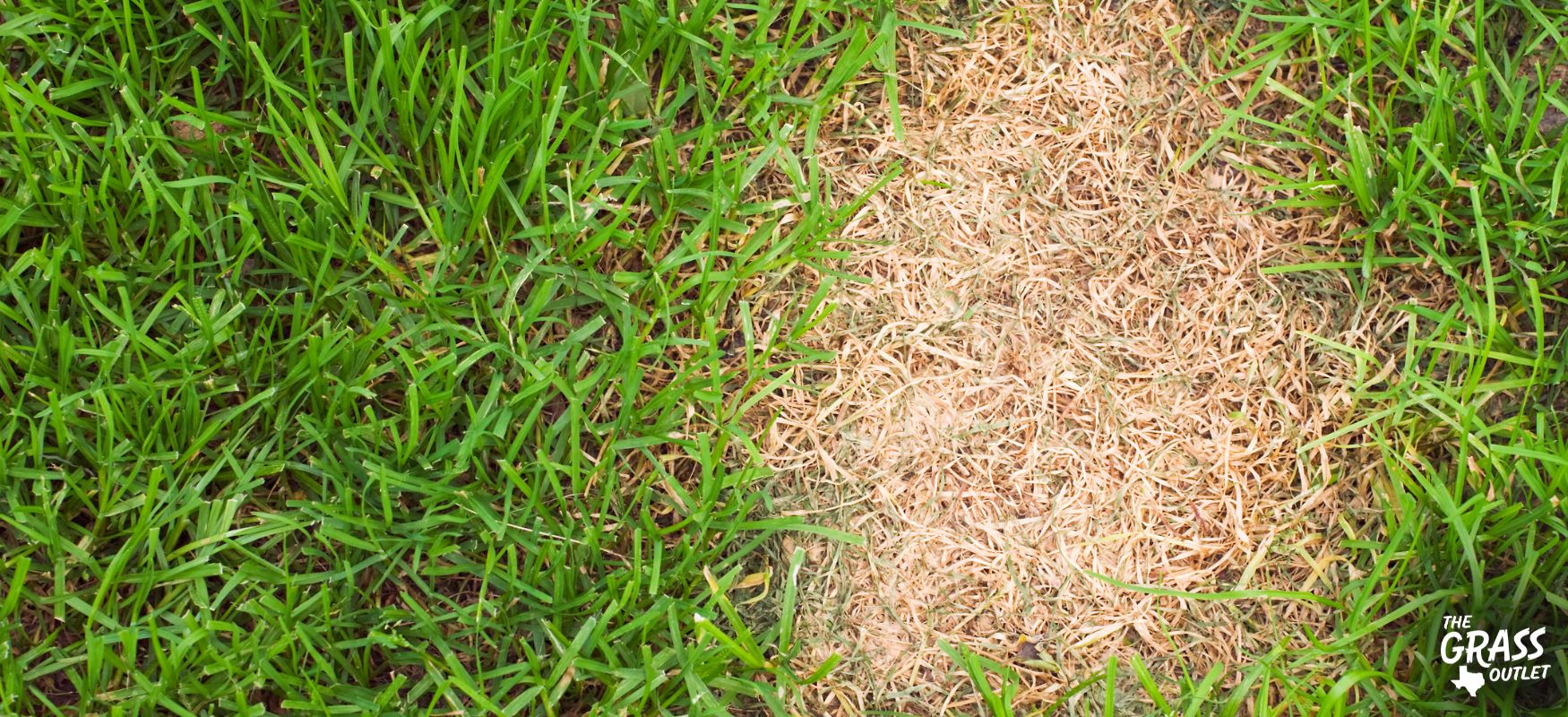
Basic Ways to Identify Lawn Fungus & Diseases
The most fail-safe way to confirm that the issue with your lawn is without a doubt being affected by a fungus is to reach out to an AgriLife Extension Service or a local lawn care professional who can come out to your property and provide expertise regarding what problems you might be facing.
A simple DIY at-home test is to pull one of your pieces of sod up and check the soil for a mushroom smell. A lack of a mushroom smell does not mean that you don’t have a fungus, but the presence of one usually indicates that your lawn has some sort of fungus-related issue.
How To Prevent Lawn Fungus & Disease
One of the most common causes of a fungus infestation is a lack of proper drainage. Ensuring that your yard is not compacted and has proper drainage is a great start to preventing excess moisture from building up and creating the perfect environment for fungus to grow. If the diseased area is in a low spot in your yard and the disease starts there every time, you are likely experiencing a drainage issue. In this instance, many products and treatments may not be enough to cure the disease, and the drainage issue will have to be remedied to prevent constant reoccurrence.
An easier fix is simply adjusting your watering schedule. Fungi infestation can often be prevented by watering early in the morning, typically before the sun has fully risen and definitely before it gets too hot outside. When you water in the evening, especially during cooler seasons, it doesn’t get hot enough outside for the sun to evaporate the excess ground moisture, which then leads to an ideal area for the fungus to take over.
Regular lawn maintenance will also make it difficult for fungus to grow. Tasks such as routinely fertilizing and watering your grass, removing excess amounts of debris and leaves, mowing periodically, aerating your lawn once a year, and applying a compost topdress in the late summer and early fall are all great preventative measures. These prevention methods are especially important in avoiding diseases like Take-All Patch.
Common Lawn Diseases in Texas
Brown Patch (Rhizoctonia)

Brown Patch is most common when outside temperatures drop below 85°F and when the air is consistently moist (especially overnight when the sun cannot evaporate excess moisture). However, it can occur during hot, humid weather, especially in overfertilized lawns. Occasionally, there is a smaller, lighter-colored halo around the diseased area that looks similar to a smoke ring. The leaves growing along the runners will turn brown and may easily slip off of the stem in the affected areas. If the runners – or stolons -keep their green color while in the diseased area, this is a good sign that the grass will grow back once a fungicide treatment has been applied. Typically, both the roots and the runners will have a healthy appearance, and the actual blades of grass are what turn brown and look infected. The most common and successful treatments are listed below.
Take All Patch (Gaeumannomyces graminis var. graminis)
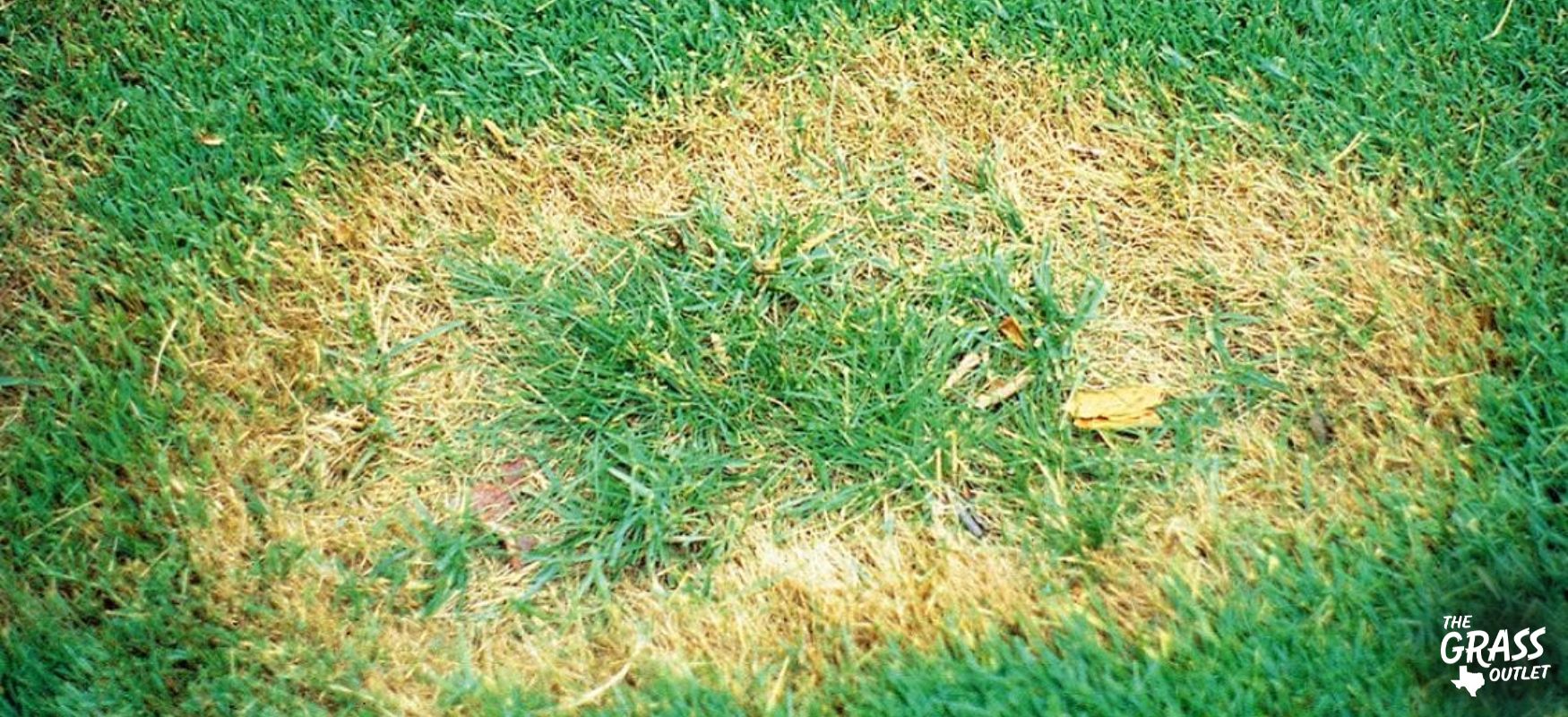
Take-All Patch is a serious disease that is most commonly found in St. Augustine grasses but can still affect Bermuda and Zoysia varieties as well. The fungus generally is most active during the fall, winter, and spring when the amount of moisture in the air is at its highest, and the temperatures are more moderate. The disease also can destroy large sections of turfgrass if left untreated and is historically difficult to control. The first symptom is often a yellowing of the leaves and darkening of the roots. The shape of the area where the leaves are discolored and dead may be circular or irregular. The infected areas typically start small and continue to grow up to 20 feet in diameter. The turf will begin to thin as the roots and stolons become infected, and the plant begins to die. Unlike Brown Patch, the leaves don’t easily fall off of the runners when pulled, and the stolons will often turn brown or black. The regrowth of the grass in affected areas is usually slow and not always successful. When the temperatures outside are extremely high, the grass will take even longer to recover.
Dollar Spot (Sclerotinia homoeocarpa)
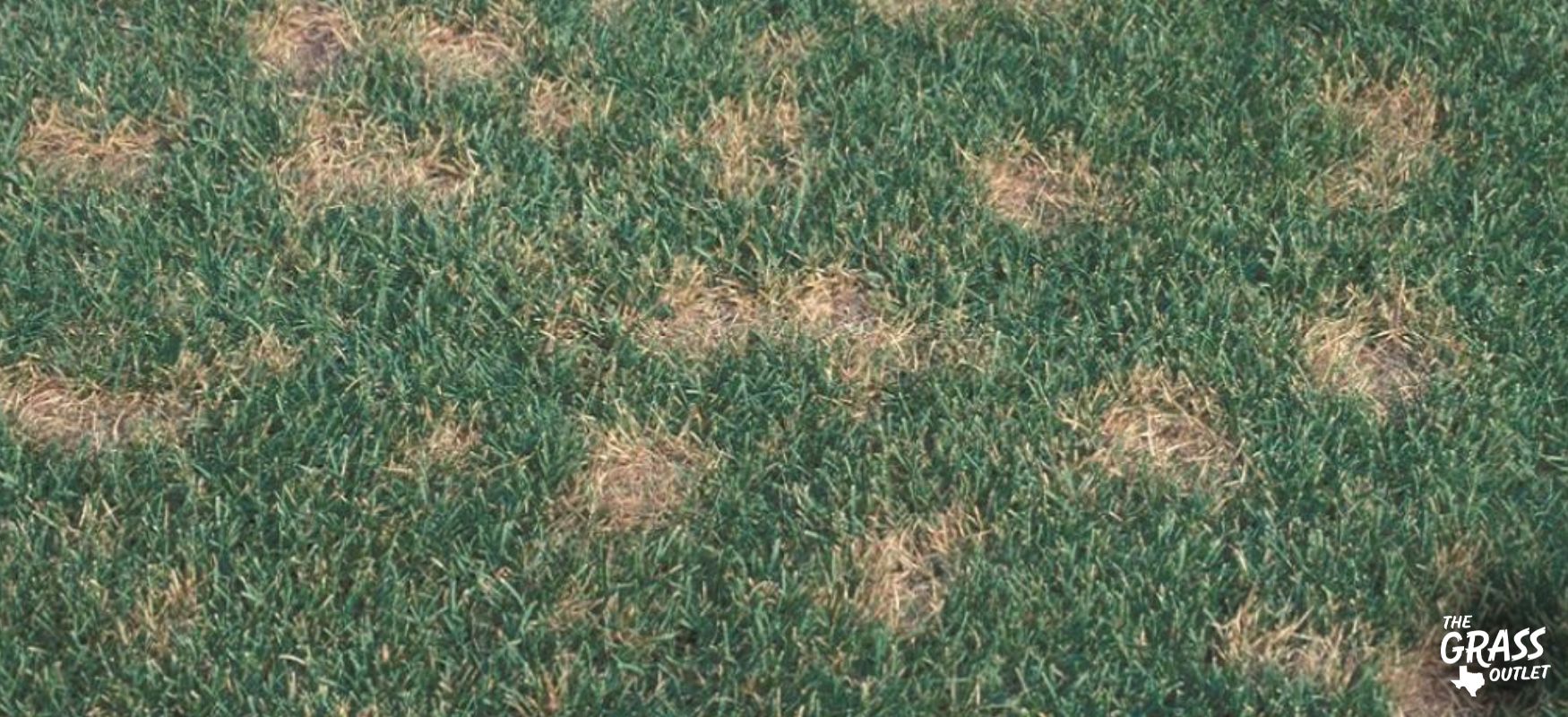
The fungus Dollar Spot attacks most turfgrasses that are grown in the South. Grasses that are the most susceptible include hybrid Bermuda varieties and Zoysia varieties. The disease frequently appears during the spring season through fall and is highly active in moist periods of days that are 70-85°F and cooler, damp nights of 60°F. The fungus is spread from one area to another by water drainage, mowers & other equipment, and foot traffic. Moisture from dew, light rain, or irrigation must be present on the leaves for the disease to develop.
The disease appears as round, brown circles that are approximately the size of a silver dollar in short grass but are slightly larger in coarse-textured and longer grass. During the early stages, affected areas may seem to be water-soaked or wilted but will quickly fade to the characteristic straw color and texture.
Gray Leaf Spot (Pyricularia grisea)
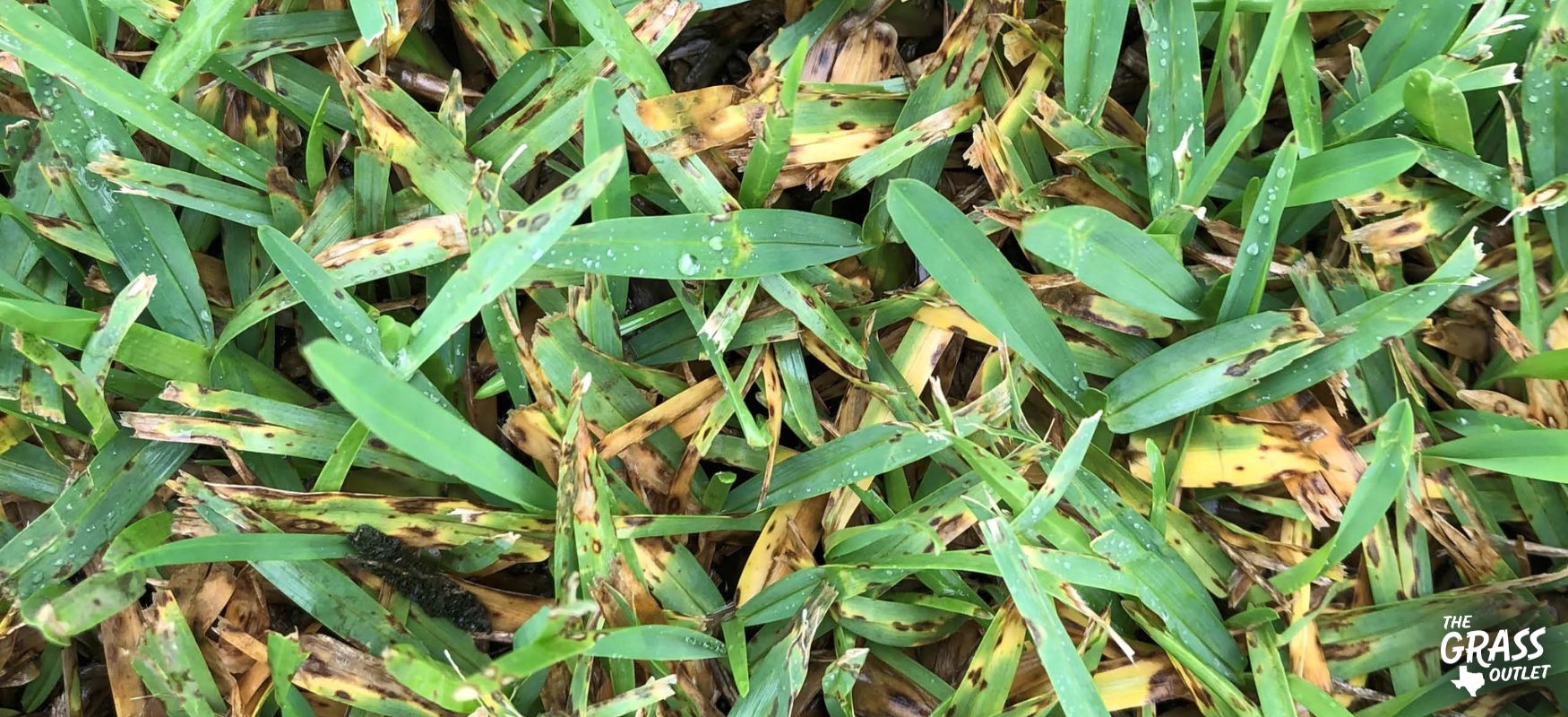
Gray leaf spot develops rapidly during warm weather seasons that are moist, typically spring and early summer. The disease mostly affects St. Augustine varieties and is most troublesome in shaded areas. It causes oval or curricular, tan-colored lesions with brown or purplish borders on the leaf blades of the grass. In severe cases, the fungus will spread to leaf sheaths and stems and cause the leaves to wither and die. In these instances, extreme thinning of the grass will likely always occur.
Decline (SAD Virus)
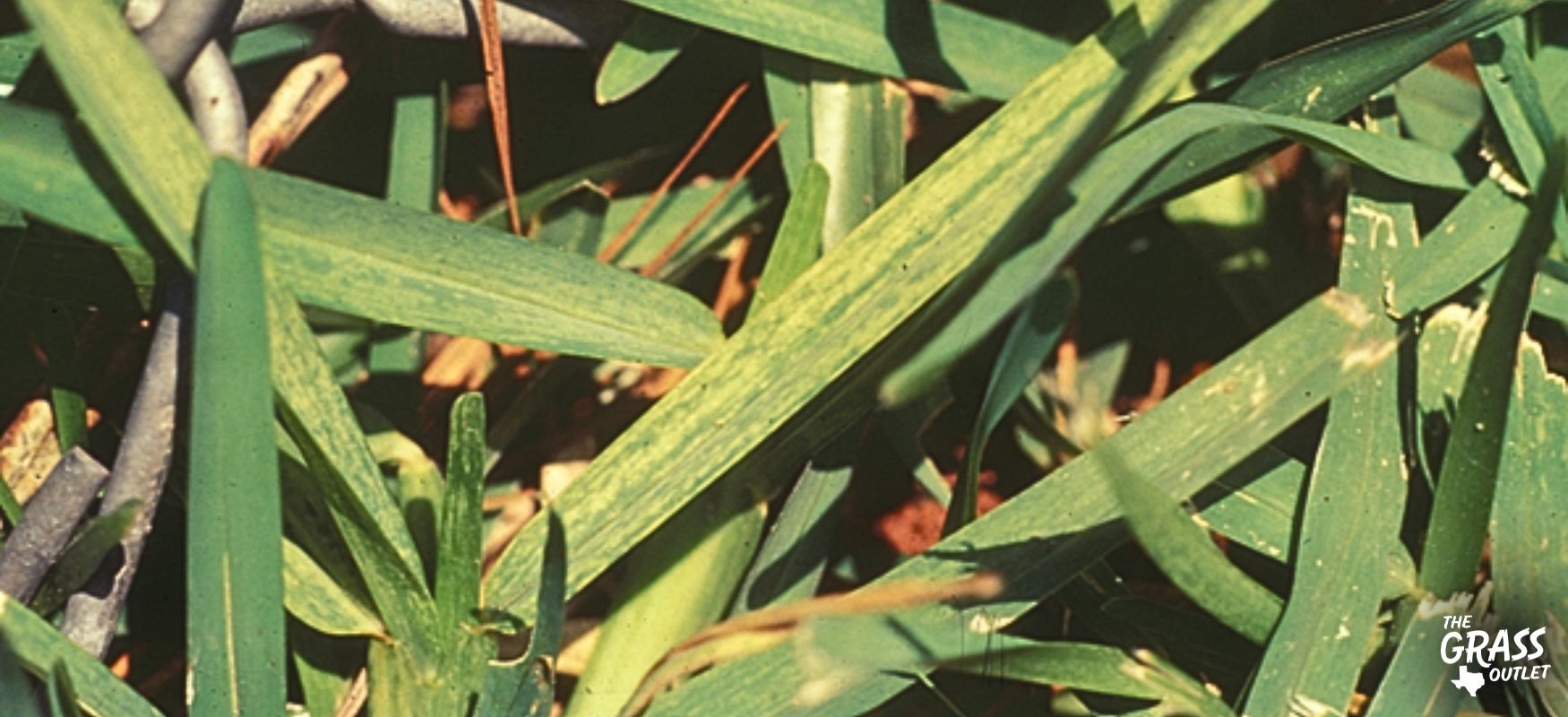
St. Augustine Decline is a disease that affects thousands of lawns in Texas every year. SAD is a true menace and can ultimately require a total uprooting and replacement of the entire lawn. The disease can be a particularly confusing issue for lawn owners because it initially looks similar to a nutrient deficiency or insect issue but is a viral issue. The blades will appear spotty and yellow, which is a sign of stress caused by the virus.
Although this appearance can sometimes be attributed to other things, if the issue is prevalent across the entire lawn, it’s most likely a sign of the St. Augustine Decline. The blades will become weak, and stolon growth will slow down. If symptoms only get worse after trying alternative maintenance such as fertilization or fungicides, it is likely the problem is past the point of return.
Due to SAD being a viral disease, there is no treatment or cure. The best thing a grass owner can do to avoid a SAD infection is to follow the recommended cultural practices for the specific cultivar. The good news is there are St. Augustines that are resistant to SAD, the most common being Raleigh St. Augustine.
Chemical Treatments
Applicable for Brown Patch, Take All Patch and Dollar Spot
There are two common chemical treatments. The first is Pillar G Intrinsic Granular Fungicide which is a combination of active ingredients Insignia fungicide and Trinity fungicide; these are both broad-spectrum disease control ingredients and easy to apply due to being in a granular form.
The second is Azoxystrobin (such as Scott’s Disease Ex), another broad-spectrum fungicide that is used to protect against foliar and soil-borne fungal diseases. It’s also currently the only active ingredient that has been found to treat all four major groups of fungal diseases.
*It is extremely important that all chemical label guidelines have been thoroughly read and are followed to avoid contamination and injury to yourself, your pets, and your lawn.
Applicable Only For Gray Leaf Spot
Two chemical fungicides can be used as preventative and curative methods for Gray Leaf Spots at varying degrees:
- Preventative: Daconil 2787 at 4 ounces intervals or Actidone Thiram at 2 ounces, both used per 1,000 square feet at 7 to 10-day intervals.
- Curative: Daconil 2787 at 6 to 8 ounces per 1,000 square feet or Actidone Thiram at 4 ounces, both used per 1,000 square feet at 7 to 10-day intervals.
Organic Treatments
Applicable for All Diseases
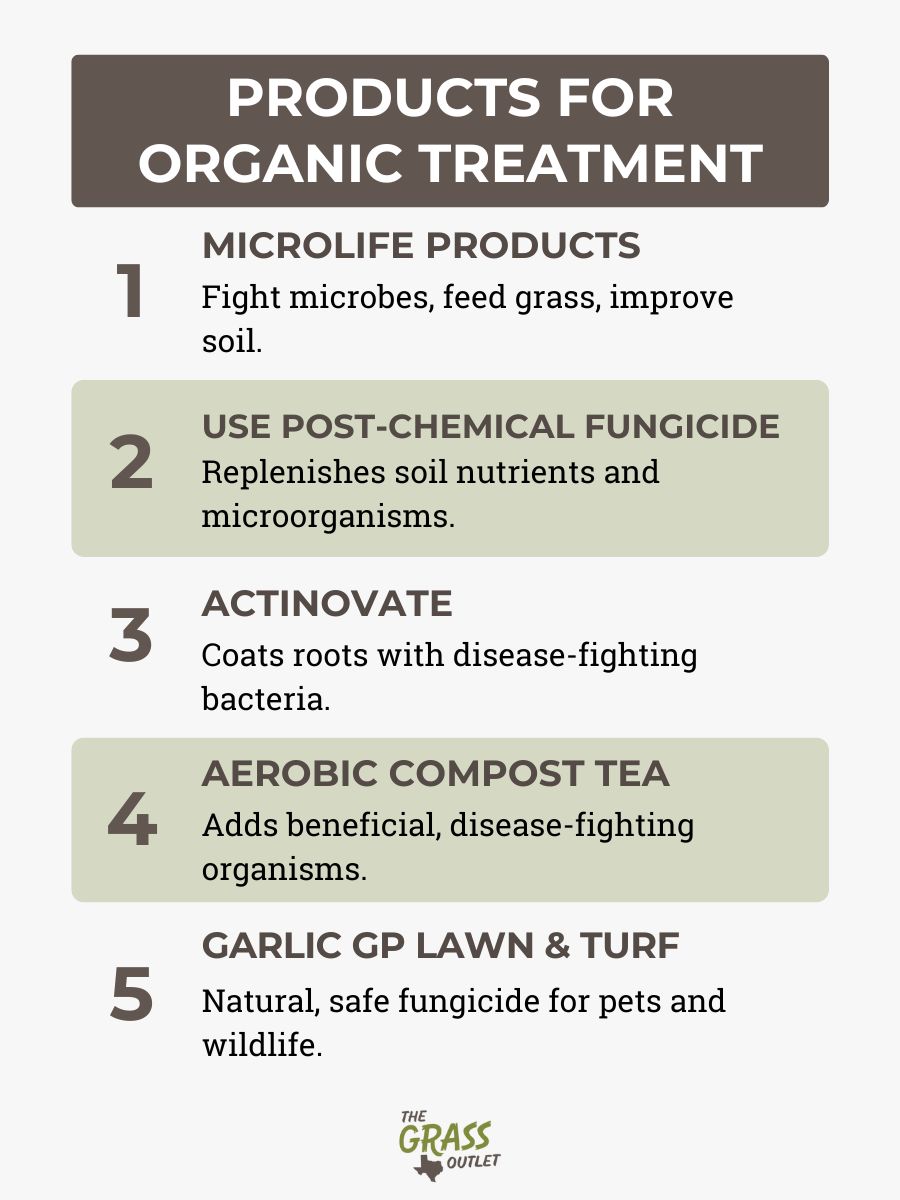
Organic treatments are substantially better for the environment but also typically less effective than chemical control. That being said, MicroLife’s Micro Grow Soil Inoculant, or MicroLife Brown Patch 5-1-3, are industry-wide favorite amongst all organic treatments. These Microlife products have the powerful ability to fight against the bad microbes while not harming the good ones, feed the grass, improve soil quality, and contain an extra 53 beneficial microbe species.
PRO TIP: The MicroLife products mentioned above are also great to use as a follow-up application two weeks after applying a chemical fungicide, as it adds all the beneficial nutrients and microorganisms back to the soil that the chemical product removes!
Actinovate is a Texas-made fungicide that stops diseases by coating the root system with agricultural bacteria called streptomyces which helps stop the disease from making its way inside the grass.
Aerobic Compost Tea, a mixture made from oxygenating and steeping compost for lawn, is reportedly effective in providing beneficial, disease-fighting organisms. Lastly, Garlic GP Lawn & Turf is an all-natural, chemical-free fungicide made up of garlic juice, potassium sulfate, and citric acid that is safe for use around children, pets, and wildlife. This treatment is easy on your grass.
In Need Of New Grass After Lawn Fungus or Disease? The Grass Outlet is Here for You
If lawn fungus or disease has damaged your lawn beyond repair, The Grass Outlet is here to help. Contact us online or over the phone today to learn more about the types of grass we offer and how we can help prevent your grass from experiencing diseases and fungus in the future.





